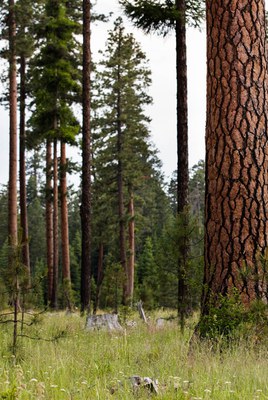In 2017, an international group of scientists released a study that attached numbers and urgency to the long-known fact that trees and other photosynthesizing plants absorb carbon, which draws down the amount of carbon dioxide in the atmosphere. The paper examined 20 different “conservation, restoration, and/or improved land management actions that increase carbon storage and/or avoid greenhouse gas emissions,” and concluded that these actions could constitute over 30% of the climate change mitigation the earth needs to stay under 2ºC by 2030.
These scientists created the term “natural climate solutions” to describe the ability of natural systems to absorb and store carbon, and it’s become the one of the hottest topics (pun intended) in conversations about solving the climate crisis. From Greta Thunberg and George Monbiot’s explanatory video to the annual United Nations climate change conference, people everywhere are thinking about how to harness nature to get us out of this human-caused mess.
So what exactly are natural climate solutions, and how do they relate to the Deschutes Land Trust?
Put simply, natural climate solutions are all of the ways that people can support the Earth to do its thing naturally, which results in storing more carbon. From replanting and restoring forests, to improving agricultural practices, to avoiding grassland conversion, there are so many ways that we can harness nature’s ability to store carbon to keep global warming below 2ºC while also making our natural systems stronger.
Natural climate solutions don’t just matter for our trees, streams, sagebrush, and wildlife, though--they also matter for the current and future generations of people in Central Oregon, who rely on forests, ranching, agriculture, fishing, and wild spaces for their prosperity.
Here’s the exciting thing: the Deschutes Land Trust’s work over the past 25 years has always incorporated natural climate solutions, even if we haven’t thought of it that way until quite recently.
So what’s the big deal if we’ve been doing this for decades at the Land Trust? The difference now is that we have a lot more information about how climate change works, how quickly it’s unfolding, and the impacts it will have in Central Oregon, which means we need to double down on the types of natural climate solutions we implement to protect our home. We also know that while climate change affects everyone, it does not affect all people equally; communities that already experience disadvantages like unsafe drinking water, living in a food desert, or systemic poverty will experience greater stresses as climate change further reduces water availability, threatens crop viability, and interferes with human health, among other impacts.
It’s important to note that natural climate solutions are absolutely not the only suite of tools we need to address climate change and climate injustice, but they are a promising start. At the Deschutes Land Trust, we’re committed to fully realizing the potential of natural climate solutions in Central Oregon, and we invite you to join us on this mission. Whether you’re planting native species to improve biodiversity of our preserves, supporting the protection and restoration of land in our area, or telling your friends and family about how nature itself can slow down climate change, you are also part of the solution. For that, the Land Trust--and the planet--thank you.
Learn more:
- The Land Trust's Climate Change Strategy
- Additional information on natural climate solutions here, here, and here
- What Can I Do About Climate Change?


